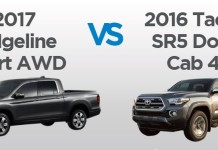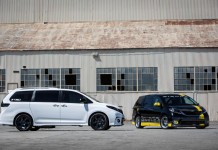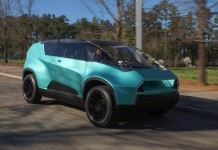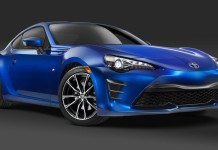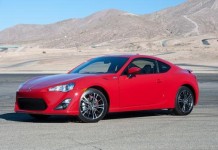When they announce the redesign of the best-selling car in America, it’s big news. The 2007 Toyota Camry is the sixth generation of Camry cars. Over 10 million Camrys have been sold worldwide since the first model rolled off the line in 1983; over 458,000 were sold in the US alone in 2005. The 2007 Toyota Camry is available in five grades: CE, LE, XLE, SE and Hybrid, with prices ranging from $18,270 to $27,520. Some of the changes are evolutionary; some are revolutionary.
Camry has always been a conservatively-styled car, and that’s not changing for 2007. The new design is fresher and younger than the previous generation, with a higher waistline and smaller windows. Bucking the obesity trend, the 2007 Camry is the same length as the previous generation (189.2″) and only 1″ wider (71.7″), so it should still fit in your garage. Curb weight is about the same as last year, between 3,285 and 3,495 lbs depending on trim level and engine selection. Front and rear fender wells sport a modest muscular bulge. Headlights and taillights have gone horizontal with housings wrapping the respective corners of the car. Overall, Camry’s looking good – not quite the youth magnet Toyota’s hoping for, but a definite improvement over the fifth generation
The five Camry grades are distinguished by slight differences in exterior styling and badging. CE, the value Camry, is the least-adorned. LE and XLE add some chrome trim and, with the optional V6 engine, dual exhausts. The sporty Camry SE sits 0.4″ lower than the other grades and features a honeycomb grille in front, a small spoiler on the rear deck lid, 17″ wheels, ground effects bodywork and an underbody aerodynamics package.
Camry’s interior has been redesigned as well. If the new interior looks at all familiar, that’s because it’s very similar to the one in the 2006 Camry Solara. The bottom of the windshield has been kicked forward a bit, and the dash sits further away from the driver and passenger, giving more of a sense of space. Dash materials are first rate, and the freshened design is sharp and tasteful. Round gauges sit above the steering wheel under an eyebrow. The center stack holds the air and heat controls, audio, and has space for an optional navigation system (SE, XLE and Hybrid only). Toyota has smartly included CD MP3 playback capability and a mini jack for auxiliary audio input on all models – a very forward-looking move.
Camry’s rear foot wells have grown, and rear legroom has increased by 0.5″ to 38.3″. The CE, LE and Hybrid grades get a 60/40 split folding rear seat. Because of body bracing to increase rigidity, the SE and XLE get fixed rear seats with a pass-through. XLE models get a deluxe 40/20/40 reclining rear seat, but pay a penalty in the trunk – the XLE’s trunk capacity is 14.5 cubic feet, while other models can fit 15.0 cubes. Overall, Camry is roomier and more comfortable than ever before, which is saying something.
Under the hood is where it gets really interesting. Camry is available with a choice of three different engines: a 2.4 liter inline 4 cylinder which cranks out 158 hp and 161 lb ft of torque; a 3.5 liter V6 that produces 268 hp and 248 lb ft of torque; and a hybrid gas-electric power plant that makes 147 hp and 137 lb ft of torque from its gas engine, and 45 hp and 203 lb ft of torque from its electric motor. Fuel economy should range from 25 city/34 highway for the 4 cylinder to 22 city/31 highway for the V6 to 43 city/37 highway/40 combined for the Hybrid.
All Camrys get independent suspension all around, with MacPherson struts up front and dual-link struts out back, ventilated 11.65″ discs in front and solid 11.06″ discs in the rear. The SE uses suspension components with firmer, sportier values than the other grades.
As a result of these changes, the V6-equipped Camrys actually approach a level of fun driving that Camry has lacked for years. The 4-cylinder Camry is competent and capable, but no thrill on the road. The Hybrid is an experience all its own, somewhere between the two conventional motors but still capable of a spirited romp. The Camry is still no sports car, but it delivers a very satisfying all-around ride.
So, does the 2007 Toyota Camry have what it takes to remain America’s best selling car? Time will tell, but I think the signs are good for the 6th generation Camry. In making evolutionary steps with the cosmetics and some revolutionary steps with the mechanical elements, Toyota has maintained the Camry lineage while raising the bar.
The Hybrid will doubtlessly be a big hit, and is a great addition to the lineup. The CE is a very nicely equipped entry-level Camry. The LE will hit a sweet spot of economy and luxury. A loaded XLE will reach a level of performance, sophistication and comfort that will merit consideration along with premium brands – but with a lower price tag. The SE will finally deliver performance that can honestly be called “sporting,” and may attract some new drivers who have stayed away previously out of boredom
Toyota’s hoping to hold on to former Camry owners and looking to pick up a new, younger crop as well. There are several challengers on the road – the Ford Five Hundred, the Nissan Maxima, the Honda Accord, the Chevrolet Malibu, the Mazda6 and even the Hyundai Sonata and Kia Optima – who would love to give the new Camry a run for the best-seller crown. I wish them all luck, and a good running start.
Source: Toyota

